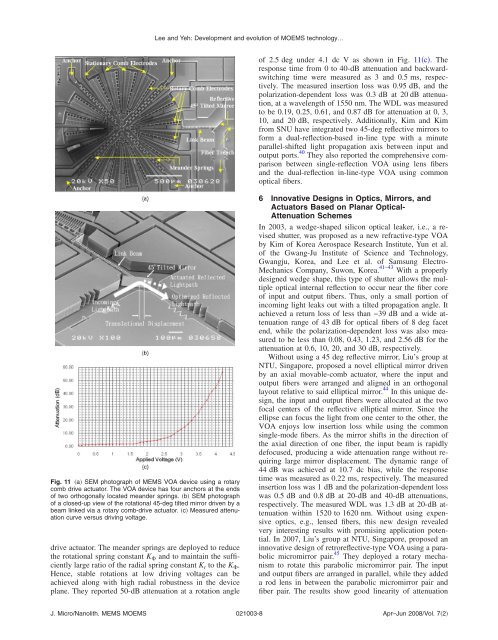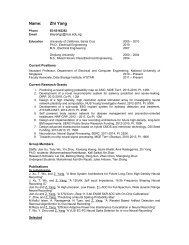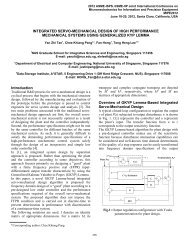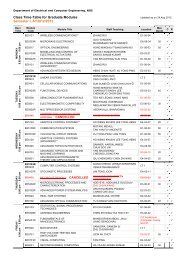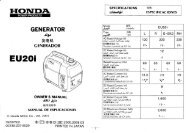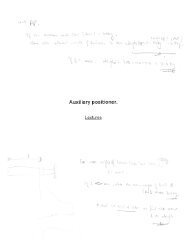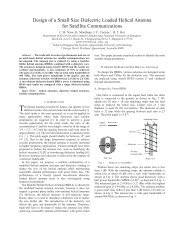Development and evolution of MOEMS technology in variable ...
Development and evolution of MOEMS technology in variable ...
Development and evolution of MOEMS technology in variable ...
You also want an ePaper? Increase the reach of your titles
YUMPU automatically turns print PDFs into web optimized ePapers that Google loves.
Lee <strong>and</strong> Yeh: <strong>Development</strong> <strong>and</strong> <strong>evolution</strong> <strong>of</strong> <strong>MOEMS</strong> <strong>technology</strong>…<br />
<strong>of</strong> 2.5 deg under 4.1 dc V as shown <strong>in</strong> Fig. 11c. The<br />
response time from 0 to 40-dB attenuation <strong>and</strong> backwardswitch<strong>in</strong>g<br />
time were measured as 3 <strong>and</strong> 0.5 ms, respectively.<br />
The measured <strong>in</strong>sertion loss was 0.95 dB, <strong>and</strong> the<br />
polarization-dependent loss was 0.3 dB at 20 dB attenuation,<br />
at a wavelength <strong>of</strong> 1550 nm. The WDL was measured<br />
to be 0.19, 0.25, 0.61, <strong>and</strong> 0.87 dB for attenuation at 0, 3,<br />
10, <strong>and</strong> 20 dB, respectively. Additionally, Kim <strong>and</strong> Kim<br />
from SNU have <strong>in</strong>tegrated two 45-deg reflective mirrors to<br />
form a dual-reflection-based <strong>in</strong>-l<strong>in</strong>e type with a m<strong>in</strong>ute<br />
parallel-shifted light propagation axis between <strong>in</strong>put <strong>and</strong><br />
output ports. 40 They also reported the comprehensive comparison<br />
between s<strong>in</strong>gle-reflection VOA us<strong>in</strong>g lens fibers<br />
<strong>and</strong> the dual-reflection <strong>in</strong>-l<strong>in</strong>e-type VOA us<strong>in</strong>g common<br />
optical fibers.<br />
Fig. 11 a SEM photograph <strong>of</strong> MEMS VOA device us<strong>in</strong>g a rotary<br />
comb drive actuator. The VOA device has four anchors at the ends<br />
<strong>of</strong> two orthogonally located me<strong>and</strong>er spr<strong>in</strong>gs. b SEM photograph<br />
<strong>of</strong> a closed-up view <strong>of</strong> the rotational 45-deg tilted mirror driven by a<br />
beam l<strong>in</strong>ked via a rotary comb-drive actuator. c Measured attenuation<br />
curve versus driv<strong>in</strong>g voltage.<br />
drive actuator. The me<strong>and</strong>er spr<strong>in</strong>gs are deployed to reduce<br />
the rotational spr<strong>in</strong>g constant K <strong>and</strong> to ma<strong>in</strong>ta<strong>in</strong> the sufficiently<br />
large ratio <strong>of</strong> the radial spr<strong>in</strong>g constant K r to the K .<br />
Hence, stable rotations at low driv<strong>in</strong>g voltages can be<br />
achieved along with high radial robustness <strong>in</strong> the device<br />
plane. They reported 50-dB attenuation at a rotation angle<br />
6 Innovative Designs <strong>in</strong> Optics, Mirrors, <strong>and</strong><br />
Actuators Based on Planar Optical-<br />
Attenuation Schemes<br />
In 2003, a wedge-shaped silicon optical leaker, i.e., a revised<br />
shutter, was proposed as a new refractive-type VOA<br />
by Kim <strong>of</strong> Korea Aerospace Research Institute, Yun et al.<br />
<strong>of</strong> the Gwang-Ju Institute <strong>of</strong> Science <strong>and</strong> Technology,<br />
Gwangju, Korea, <strong>and</strong> Lee et al. <strong>of</strong> Samsung Electro-<br />
Mechanics Company, Suwon, Korea. 41–43 With a properly<br />
designed wedge shape, this type <strong>of</strong> shutter allows the multiple<br />
optical <strong>in</strong>ternal reflection to occur near the fiber core<br />
<strong>of</strong> <strong>in</strong>put <strong>and</strong> output fibers. Thus, only a small portion <strong>of</strong><br />
<strong>in</strong>com<strong>in</strong>g light leaks out with a tilted propagation angle. It<br />
achieved a return loss <strong>of</strong> less than −39 dB <strong>and</strong> a wide attenuation<br />
range <strong>of</strong> 43 dB for optical fibers <strong>of</strong> 8 deg facet<br />
end, while the polarization-dependent loss was also measured<br />
to be less than 0.08, 0.43, 1.23, <strong>and</strong> 2.56 dB for the<br />
attenuation at 0.6, 10, 20, <strong>and</strong> 30 dB, respectively.<br />
Without us<strong>in</strong>g a 45 deg reflective mirror, Liu’s group at<br />
NTU, S<strong>in</strong>gapore, proposed a novel elliptical mirror driven<br />
by an axial movable-comb actuator, where the <strong>in</strong>put <strong>and</strong><br />
output fibers were arranged <strong>and</strong> aligned <strong>in</strong> an orthogonal<br />
layout relative to said elliptical mirror. 44 In this unique design,<br />
the <strong>in</strong>put <strong>and</strong> output fibers were allocated at the two<br />
focal centers <strong>of</strong> the reflective elliptical mirror. S<strong>in</strong>ce the<br />
ellipse can focus the light from one center to the other, the<br />
VOA enjoys low <strong>in</strong>sertion loss while us<strong>in</strong>g the common<br />
s<strong>in</strong>gle-mode fibers. As the mirror shifts <strong>in</strong> the direction <strong>of</strong><br />
the axial direction <strong>of</strong> one fiber, the <strong>in</strong>put beam is rapidly<br />
defocused, produc<strong>in</strong>g a wide attenuation range without requir<strong>in</strong>g<br />
large mirror displacement. The dynamic range <strong>of</strong><br />
44 dB was achieved at 10.7 dc bias, while the response<br />
time was measured as 0.22 ms, respectively. The measured<br />
<strong>in</strong>sertion loss was 1 dB <strong>and</strong> the polarization-dependent loss<br />
was 0.5 dB <strong>and</strong> 0.8 dB at 20-dB <strong>and</strong> 40-dB attenuations,<br />
respectively. The measured WDL was 1.3 dB at 20-dB attenuation<br />
with<strong>in</strong> 1520 to 1620 nm. Without us<strong>in</strong>g expensive<br />
optics, e.g., lensed fibers, this new design revealed<br />
very <strong>in</strong>terest<strong>in</strong>g results with promis<strong>in</strong>g application potential.<br />
In 2007, Liu’s group at NTU, S<strong>in</strong>gapore, proposed an<br />
<strong>in</strong>novative design <strong>of</strong> retroreflective-type VOA us<strong>in</strong>g a parabolic<br />
micromirror pair. 45 They deployed a rotary mechanism<br />
to rotate this parabolic micromirror pair. The <strong>in</strong>put<br />
<strong>and</strong> output fibers are arranged <strong>in</strong> parallel, while they added<br />
a rod lens <strong>in</strong> between the parabolic micromirror pair <strong>and</strong><br />
fiber pair. The results show good l<strong>in</strong>earity <strong>of</strong> attenuation<br />
J. Micro/Nanolith. MEMS <strong>MOEMS</strong> 021003-8<br />
Apr–Jun 2008/Vol. 72


